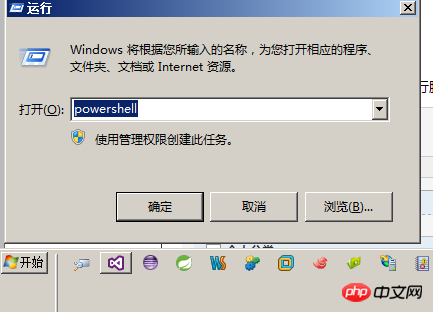Home >Operation and Maintenance >Linux Operation and Maintenance >The definition and use of PowerShell and Bash
PowerShell是运行在windows平台的脚本,而Bash是运行在linux平台的脚本
现在bash能做的事情,PowerShell也能做,PowerShell的强大之处是它可以管理windows服务器(特别是域domain),现在的开源PowerShell 也可以管理Linux和Mac(通过PSRP)。
下载最新的PS程序
安装后它会有powershell和它的开发IDE工具,ISE,非常不错!
一、进行powershell的程序

二、创建脚本,简单的Helloworld.ps1
任务的自动化是以程序文件或者可执行脚本文件为基础的,PowerShell也支持将命令列表做成脚本文件来执行。以下是Helloworld.ps1脚本文件的内容:
$a = "Hello World!"$a echo $a > a.txt dir a.txt
Helloworld.ps1脚本文件的执行情况结果如下:
PS E:\>.\Helloworld.ps1 --注意在执行它时要加.\,表示当前上当下的文章,类似于centos里的文件执行方法<br><code class="javascript plain">Hello world!Directory: E:\Mode LastWriteTime Length Name ---- ------------- ------ ---- -a--- 5/30/2017 4:56 PM 16 a.txt <br>
下面是在eShopOnContainers上的一个例子,分别用ps和bash实现了程序的部署
#!/bin/bash
declare -a projectList=('../src/Services/Catalog/Catalog.API''../src/Services/Basket/Basket.API''../src/Services/Ordering/Ordering.API''../src/Services/Identity/Identity.API''../src/Web/WebMVC''../src/Web/WebSPA''../src/Web/WebStatus')
# Build SPA app
# pushd $(pwd)../src/Web/WebSPA
# npm run build:prodfor project in "${projectList[@]}"doecho -e "\e[33mWorking on $(pwd)/$project"echo -e "\e[33m\tRemoving old publish output"pushd $(pwd)/$project
rm -rf obj/Docker/publish
echo -e "\e[33m\tRestoring project"dotnet restore
echo -e "\e[33m\tBuilding and publishing projects"dotnet publish -o obj/Docker/publish
popd
done
# remove old docker images:
images=$(docker images --filter=reference="eshop/*" -q)if [ -n "$images" ]; then
docker rm $(docker ps -a -q) -f
echo "Deleting eShop images in local Docker repo"echo $images
docker rmi $(docker images --filter=reference="eshop/*" -q) -f
fi
# No need to build the images, docker build or docker compose will
# do that using the images and containers defined in the docker-compose.yml file.powershell代码如下
Param([string] $rootPath)
$scriptPath = Split-Path $script:MyInvocation.MyCommand.Path
Write-Host "Current script directory is $scriptPath" -ForegroundColor Yellowif ([string]::IsNullOrEmpty($rootPath)) {
$rootPath = "$scriptPath\.."}
Write-Host "Root path used is $rootPath" -ForegroundColor Yellow
$projectPaths =
@{Path="$rootPath\src\Web\WebMVC";Prj="WebMVC.csproj"},
@{Path="$rootPath\src\Web\WebSPA";Prj="WebSPA.csproj"},
@{Path="$rootPath\src\Services\Identity\Identity.API";Prj="Identity.API.csproj"},
@{Path="$rootPath\src\Services\Catalog\Catalog.API";Prj="Catalog.API.csproj"},
@{Path="$rootPath\src\Services\Ordering\Ordering.API";Prj="Ordering.API.csproj"},
@{Path="$rootPath\src\Services\Basket\Basket.API";Prj="Basket.API.csproj"}
@{Path="$rootPath\src\Web\WebStatus";Prj="WebStatus.csproj"}
$projectPaths | foreach {
$projectPath = $_.Path
$projectFile = $_.Prj
$outPath = $_.Path + "\obj\Docker\publish"$projectPathAndFile = "$projectPath\$projectFile"Write-Host "Deleting old publish files in $outPath" -ForegroundColor Yellow
remove-item -path $outPath -Force -Recurse -ErrorAction SilentlyContinue
Write-Host "Publishing $projectPathAndFile to $outPath" -ForegroundColor Yellow
dotnet restore $projectPathAndFile
dotnet build $projectPathAndFile
dotnet publish $projectPathAndFile -o $outPath
}
########################################################################################
# Delete old eShop Docker images
########################################################################################
$imagesToDelete = docker images --filter=reference="eshop/*" -q
If (-Not $imagesToDelete) {Write-Host "Not deleting eShop images as there are no eShop images in the current local Docker repo."}
Else
{
# Delete all containers
Write-Host "Deleting all containers in local Docker Host"docker rm $(docker ps -a -q) -f
# Delete all eshop images
Write-Host "Deleting eShop images in local Docker repo"Write-Host $imagesToDelete
docker rmi $(docker images --filter=reference="eshop/*" -q) -f
}
# WE DON'T NEED DOCKER BUILD AS WE CAN RUN "DOCKER-COMPOSE BUILD" OR "DOCKER-COMPOSE UP" AND IT WILL BUILD ALL THE IMAGES IN THE .YML FOR US自己感觉,这两个东西在以后的程序部署上都会发挥各自强大的力量!
The above is the detailed content of The definition and use of PowerShell and Bash. For more information, please follow other related articles on the PHP Chinese website!